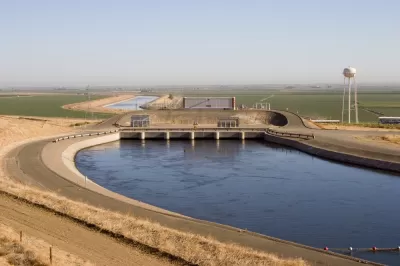The declaration applies to all of California's 58 counties, with agencies and households urged to implement stricter conservation measures as the historic drought deepens.

Declaring a statewide drought emergency on Tuesday, Governor Gavin Newsom urged Californians to redouble their efforts to conserve water "[a]s the western U.S. faces a potential third year of drought." Ian James reports that "[t]he declaration came as state water officials announced that Californians had cut their water usage by 5% in August, a modest improvement over July, when water use decreased by 1.8%." The governor's proclamation allows the State Water Resources Control Board to potentially "adopt emergency regulations to prohibit wasting water, such as hosing down sidewalks or driveways, allowing drinking water to flood gutters or streets, or washing a car without a shut-off nozzle."
While most of California was already under a state of drought emergency, "Newsom’s proclamation added the last eight remaining counties, and further bolstered his call for everyone to voluntary reduce water use by 15%." The state faces a growing "moisture deficit," and "an estimated 140% of average statewide precipitation would be needed in the coming year to achieve average statewide runoff."
The board of directors for Metropolitan Water District of Southern California—a region that is home to more than half of the state's population—"will consider next month whether to urge member water agencies across Southern California 'to implement mandatory conservation in their communities, as outlined in their water shortage contingency plans.'"
In addition to saving water, a report found that "improving water-use efficiency in urban areas offers the greatest potential for reducing water-related energy use and emissions that contribute to global warming."
FULL STORY: Newsom declares statewide drought emergency, urges California to conserve water

Alabama: Trump Terminates Settlements for Black Communities Harmed By Raw Sewage
Trump deemed the landmark civil rights agreement “illegal DEI and environmental justice policy.”

Study: Maui’s Plan to Convert Vacation Rentals to Long-Term Housing Could Cause Nearly $1 Billion Economic Loss
The plan would reduce visitor accommodation by 25% resulting in 1,900 jobs lost.

Why Should We Subsidize Public Transportation?
Many public transit agencies face financial stress due to rising costs, declining fare revenue, and declining subsidies. Transit advocates must provide a strong business case for increasing public transit funding.

Paris Bike Boom Leads to Steep Drop in Air Pollution
The French city’s air quality has improved dramatically in the past 20 years, coinciding with a growth in cycling.

Why Housing Costs More to Build in California Than in Texas
Hard costs like labor and materials combined with ‘soft’ costs such as permitting make building in the San Francisco Bay Area almost three times as costly as in Texas cities.

San Diego County Sees a Rise in Urban Coyotes
San Diego County experiences a rise in urban coyotes, as sightings become prevalent throughout its urban neighbourhoods and surrounding areas.
Urban Design for Planners 1: Software Tools
This six-course series explores essential urban design concepts using open source software and equips planners with the tools they need to participate fully in the urban design process.
Planning for Universal Design
Learn the tools for implementing Universal Design in planning regulations.
Smith Gee Studio
Alamo Area Metropolitan Planning Organization
City of Santa Clarita
Institute for Housing and Urban Development Studies (IHS)
City of Grandview
Harvard GSD Executive Education
Toledo-Lucas County Plan Commissions
Salt Lake City
NYU Wagner Graduate School of Public Service





























